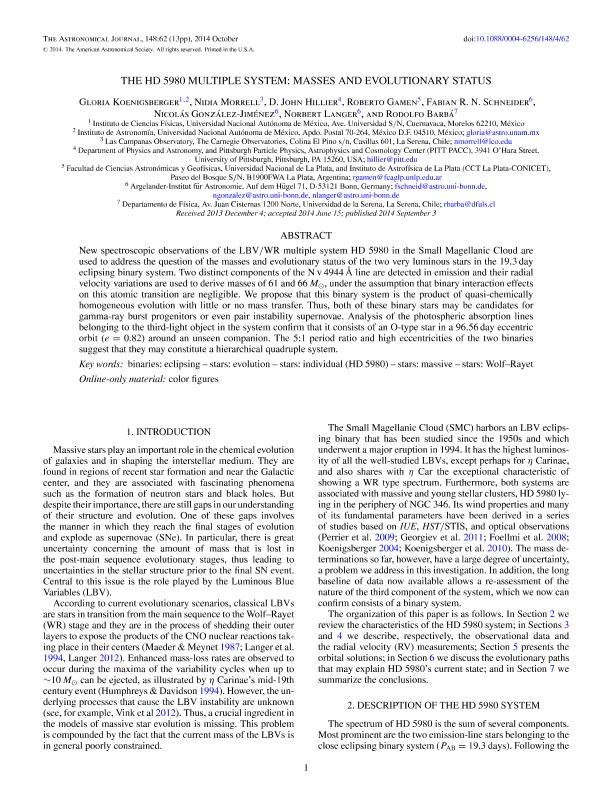Mostrar el registro sencillo del ítem
dc.contributor.author
Koenigsberger, Gloria
dc.contributor.author
Morrell, Nidia Irene

dc.contributor.author
Hillier, D. John
dc.contributor.author
Gamen, Roberto Claudio

dc.contributor.author
Schneider, Fabian
dc.contributor.author
González Jiménez, Nicolás
dc.contributor.author
Langer, Norbert
dc.contributor.author
Barba, Rodolfo Hector

dc.date.available
2017-01-06T17:27:48Z
dc.date.issued
2014-10
dc.identifier.citation
Koenigsberger, Gloria; Morrell, Nidia Irene; Hillier, D. John; Gamen, Roberto Claudio; Schneider, Fabian; et al.; The HD 5980 multiple system: masses and evolutionary status; Iop Publishing; Astronomical Journal; 148; 4; 10-2014; 62-75
dc.identifier.issn
0004-6256
dc.identifier.uri
http://hdl.handle.net/11336/10919
dc.description.abstract
New spectroscopic observations of the LBV/WR multiple system HD 5980 in the Small Magellanic Cloud are used to address the question of the masses and evolutionary status of the two very luminous stars in the 19.3 day eclipsing binary system. Two distinct components of the N V 4944 Å line are detected in emission and their radial velocity variations are used to derive masses of 61 and 66 M ☉, under the assumption that binary interaction effects on this atomic transition are negligible. We propose that this binary system is the product of quasi-chemically homogeneous evolution with little or no mass transfer. Thus, both of these binary stars may be candidates for gamma-ray burst progenitors or even pair instability supernovae. Analysis of the photospheric absorption lines belonging to the third-light object in the system confirm that it consists of an O-type star in a 96.56 day eccentric orbit (e = 0.82) around an unseen companion. The 5:1 period ratio and high eccentricities of the two binaries suggest that they may constitute a hierarchical quadruple system.
dc.format
application/pdf
dc.language.iso
eng
dc.publisher
Iop Publishing

dc.rights
info:eu-repo/semantics/openAccess
dc.rights.uri
https://creativecommons.org/licenses/by-nc-sa/2.5/ar/
dc.subject
Eclipsing Binaries
dc.subject
Evolution of Stars
dc.subject
Hd 5980 (Estrella)
dc.subject
Massive Stars
dc.subject
Wolf Rayet Stars
dc.subject.classification
Astronomía

dc.subject.classification
Ciencias Físicas

dc.subject.classification
CIENCIAS NATURALES Y EXACTAS

dc.title
The HD 5980 multiple system: masses and evolutionary status
dc.type
info:eu-repo/semantics/article
dc.type
info:ar-repo/semantics/artículo
dc.type
info:eu-repo/semantics/publishedVersion
dc.date.updated
2017-01-02T18:36:42Z
dc.journal.volume
148
dc.journal.number
4
dc.journal.pagination
62-75
dc.journal.pais
Estados Unidos

dc.journal.ciudad
Londres
dc.description.fil
Fil: Koenigsberger, Gloria. Universidad Nacional Autónoma de México; México
dc.description.fil
Fil: Morrell, Nidia Irene. The Carnegie Observatories. Las Campanas Observatory; Chile. Consejo Nacional de Investigaciones Científicas y Técnicas. Centro Científico Tecnológico La Plata. Instituto de Astrofísica de La Plata; Argentina
dc.description.fil
Fil: Hillier, D. John. University Of Pittsburgh; Estados Unidos
dc.description.fil
Fil: Gamen, Roberto Claudio. Consejo Nacional de Investigaciones Científicas y Técnicas. Centro Científico Tecnológico la Plata. Instituto de Astrofísica de la Plata; Argentina. Universidad Nacional de la Plata. Facultad de Ciencias Astronómicas y Geofísicas; Argentina
dc.description.fil
Fil: Schneider, Fabian. Argelander-Institut fur Astronomie; Alemania
dc.description.fil
Fil: González Jiménez, Nicolás. Argelander-Institut für Astronomie; Alemania
dc.description.fil
Fil: Langer, Norbert. Argelander-Institut für Astronomie; Alemania
dc.description.fil
Fil: Barba, Rodolfo Hector. Universidad de la Serena; Chile
dc.journal.title
Astronomical Journal

dc.relation.alternativeid
info:eu-repo/semantics/altIdentifier/doi/http://dx.doi.org/10.1088/0004-6256/148/4/62
dc.relation.alternativeid
info:eu-repo/semantics/altIdentifier/url/http://iopscience.iop.org/article/10.1088/0004-6256/148/4/62/meta
Archivos asociados
